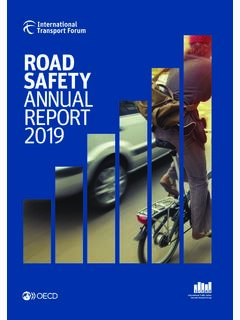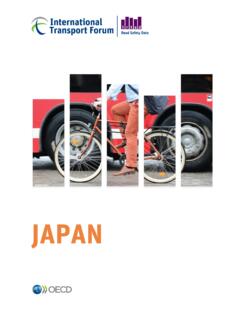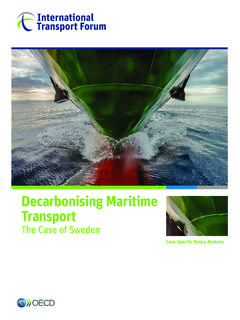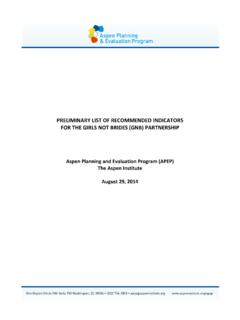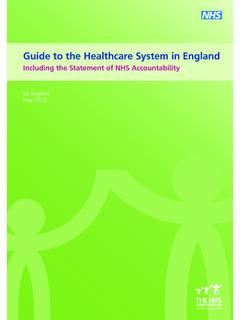Transcription of Elderly Road Users and Pedestrians - Home | ITF
1 Vulnerable road user Safety: ChildrenElderlRoadUsersandPedestriansChi ldren, Elderly road Users and PedestriansKate Mc MahonHigh Level Seminar on road Safety Paris, 25 26 September 2008 Three OECD And a new working group on pedestrian safety and mobility started in 2008 High Level Seminar on road Safety Paris, 25 26 September 2008 KiChildSfiTffiKeeping Children safe in Traffic An estimated 100,000 children in OECD countries diedin road related crashes since the OECD report on children s transport safety was published in The RTR Working Group on Child road Safety was organised in 2001 to address this subject. Thestudyaimedtoreduceroadtraumatochildre nthroughtheThe study aimed to reduce road trauma to children through the identification of trends and factors affecting their safety, and by the collection, dissemination, and promotion of the best road safety practicesprogrammespoliciesandcountermea suresavailableinpractices, programmes, policies, and counter measures available in OECD Member Level Seminar on road Safety Paris, 25 26 September 2008Ah/hdlApproach/methodologyThe study focused on four key areas: Thescaleandnatureoftheproblem The scale and nature of the problem.
2 Children s behaviour, abilities and education, training and publicity approaches. The role of the road environment in relation to child safety. Theroleoflegislationandstandardsinroadsa fetyequipmentandvehicles The role of legislation and standards in road safety equipment and Level Seminar on road Safety Paris, 25 26 September 2008 SldfhblScale and nature of the problem road crashes accounted for 41% of child injury fatalities in OECD traffic, 41%Other/uninIntentional, 14% There are large variations between OECD countries in the performance of child road , 15%tentional, 23%safety. Worldwide 300,000 children die in road crashes each year, half in Africa and S. E. , 7%High Level Seminar on road Safety Paris, 25 26 September 2008 Kfi didRdtiKey findings and Recommendations:Strategy Countries with a good child road safety record tend also to have a good overall traffic safety record characterised by gyyhaving a well established and integrated approach.
3 The best performing OECD countries have adopted a holistic approachusingawidevarietyofmeasuresappro ach using a wide variety of measures. road Safety policy should include specific strategies and targets for improving child safety. For example in GB the 50% targetforchildKSIwasachievedin10yearstar get for child KSI was achieved in 10 Level Seminar on road Safety Paris, 25 26 September 2008 Key findings and Recommendations: Education, training and publicity Education, practical training, and publicity encourage safe behaviour by influencing knowledge and attitudes, and providing young peoplewiththeskillsandstrategiestomanage people with the skills and strategies to manage risks. keeping children safe is everyone s responsibility parents, schools, drivers, policy makers, plannersmanufacturersplanners, manufacturers.
4 Drivers need to understand the limitations of children s behaviour in traffic. Driver training and publicity campaigns should be used to shift the focus of responsibility from children to Level Seminar on road Safety Paris, 25 26 September 2008 KeyfindingsandRecommendations:Key findings and Recommendations: The built environment Young children need space for tilidhilcongregating, playing and physical activity. Older children require safe and secure routes to access school, playgrounds and other recreational destinations, both as Pedestrians and as cyclists. TrafficengineersandplannersTraffic engineers and planners should take children s needs and abilities into account and incorporate them into road plans traffic designs. Cyclists and Pedestrians need more priority through the use of traffic calming and facilities for walkingandcyclingHigh Level Seminar on road Safety Paris, 25 26 September 2008walking and findings and Recommendations:Vehicles and safety equipment Children in cars should use suitable restraintsfor their age and Vehicle design passive safety systems such as crumple zones and safety door and window locks.
5 + more attention to protecting Pedestrians and cyclists. pgpy Cycle helmets should be positively promoted, particularly among children, as part of an integrated approach to flsafer Level Seminar on road Safety Paris, 25 26 September 2008 Seat belts and child restraints save lives High rates of use of child restraints in W. Europe over 90% in Many countries do not have information on wearing rates and do not have legislation. USdatashowthatover70%ofchilddeathscould US data show that over 70% of child deaths could be prevented if suitable restraints were in use. Legislation must be supported by long running gppyggeducation and publicity campaigns and enforcement and effective Level Seminar on road Safety Paris, 25 26 September 2008 Child safety: conclusions Traffic calmingand facilities for safe walking and cycling can reduce crashes by around a third.
6 Child restraintscan reduce deaths by 70% if correctly fitted and used. A targeted strategic approachthat prioritises child safety and shifts responsibility from children to diidddrivers is Level Seminar on road Safety Paris, 25 26 September 2008 AidTtAgeing and Transport:Mobility needs and safety issues Older people are the fastest growing group 12 drivers. Older drivers and passengers have shown most increase in in the last decade. Older drivers do not disproportionately contribute to pedestrian aged 70+p Older vehicle occupants are frail and are more likely to die in a Level Seminar on road Safety Paris, 25 26 September 2008 Kfi diddtiKey findings and recommendations:vulnerability Age related disabilities affect the use of other modes of transport earlier than private car driving. Older drivers as a group do not have higher accident involvement gpgthan other age groups; their overrepresentation in accident statistics is due to increased risk of injury and death and certain biases in measurement.
7 The main safety problem: their increased physical frailty and heightened vulnerability to injury and death if involved in Level Seminar on road Safety Paris, 25 26 September 2008 Kfi diddtiKey findings and recommendations: support for older drivers Car driving Elderly should be encouraged and supported in their effort to prolong their driving career as long as possible; age based mandatory driver screening practices should not be gygpapplied. Diagnostic and rehabilitation efforts should focus on drivers withsignificantfunctionalimpairmentswith significant functional impairments. Community based referral system for safe driving assessments. Define more clearly and support driver assessment and rehabilitation Level Seminar on road Safety Paris, 25 26 September 2008 Kfi diddtiKey findings and recommendations: infrastructure and vehicle design Infrastructure design focused on technical efficiency and low costs is no longer sufficient; standards based on fit young males are inappropriate in an ageing society.
8 Provide safer roads for Pedestrians and Users of scooters and wheelchairs. In W Europe 45% of pedestrian fatalities are aged 65 or more. More forgiving and predictable road design to reduce need to make ggpgcomplex decisions and perform time related tasks. Vehicle design should be improved in terms of useability, occupant protection, and technical ,High Level Seminar on road Safety Paris, 25 26 September 2008 Cli T tPliPi itifConclusions:Transport Policy Priorities for an Ageing Population Mobility is the key issue. Support and funding to enable lifelong mobility including continuing to drive safely. Provisionofsuitabletransportalternatives totheprivatecar Provision of suitable transport alternativesto the private car. Options include accessible buses, taxis, Dial a Ride, mobility scooters and powered tfldlilidl t Involvement of older people in policy development.
9 Educational campaigns to promote maximum mobility and safety for older people. Improvements in infrastructure, vehicle design, etc. that benefit the Elderly will benefit Level Seminar on road Safety Paris, 25 26 September 2008 SftfVl blRdUSafety of Vulnerable road Users : Pedestrians In most OECD countries Pedestrians are the second largest group of road n g ar yUk r ain eBulgariaJapan LithuaniaPolandKo r e aMe xico road networks have largely been designed for the use of motorised traffic at the expense r m anySpainSwedenAustriaGre e ce (2003)Por tugalIre land (2003)Sw itze r landCzech RepublicGreat Britainof vulnerable road Users . Progress has been made in OECD countries to adapt the environment in residential areas NNe w Ze alandBe lgiumFr an ceUnited StatesDe n m ar kCanadaFin lan dItaly Slove niaAustraliaPedestrian (% of total fatalities)and city centres to provide better for vulnerable road t h e r lan d sNorw ayHigh Level Seminar on road Safety Paris, 25 26 September 2008 pedestrian safety: key conclusions More equitable allocation of road space and greater priority for vulnerable modes.
10 Reducing vehicle speeds and promoting traffic integration in built up areas through traffic calming and traffic management. Vehicle design measures such as speed gplimitation technology and design of vehicle Level Seminar on road Safety Paris, 25 26 September 2008 CliConclusions All three reports are consistent in their emphasis on a holistic approach combining infrastructure measures withvehicledesignandbehaviouralmeasuresw ith vehicle design and behavioural measures. More emphasis in the child safety report on the importance of strategic road safety planning. Clear emphasis on the need to shift responsibility for safety away from vulnerable road Users , especially childrenandtheelderlytowardsdriverschild ren and the Elderly , towards drivers. Strong role for infrastructure and traffic and speed Level Seminar on road Safety Paris, 25 26 September 2008

